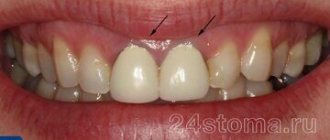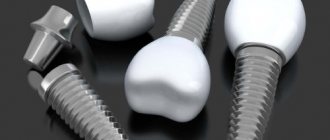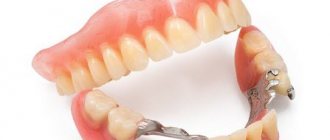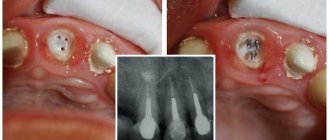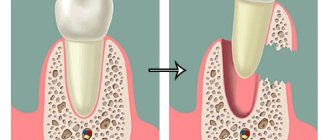Chief editor of the site:
Snitkovsky Arkady Alexandrovich
Chief physician of the professorial dentistry “22 Century”, dentist, orthopedic dentist
Author of the article:
Scientific team of dentistry “22 Century”
Dentists, candidates and doctors of medical sciences, professors
Types of Dental Implants
Today, every modern dental clinic offers such a service as dental implantation. Let's look at the basic terms and concepts, as well as types of dental implants.
Basic terms
- A dental implant is a structure that is installed into the jaw bone during surgery and replaces the roots of the teeth, and also serves as a support for prosthetics;
- An abutment is a supragingival structure that imitates a tooth stump. It can be integral with the implant (non-separable design) or as a separate structure (demountable design);
- The healing abutment is a supragingival intermediate structure. Essential for creating a beautiful natural gum margin. (in the case where the abutment and implant are a single whole, not used);
- Osseointegration is a direct structural and functional connection between living bone tissue and the surface of the implant implanted into it.
Distinctive characteristics of Ankylosis implants:
- Cone shape . It is this that increases the survival rate of Ankylos implants.
- Friadent Plus special coating , which accelerates the formation of new bone tissue around the implant.
- The survival rate of structures is 99%.
- Roughness on the surface of the implant, which helps create a strong, reliable support for the abutment and the absence of micro-movements.
- The shape and coating of the structure allows the use of implants for patients with any bone density .
- Progressive carving . Provides reliable contact between the bone and the implant, and also helps eliminate the possibility of micro-movements.
- Manufacturing of implants from high-quality titanium .
- Tightness of connections of all implant elements.
- No possibility of infection.
Implantation can be:
- Direct (performed immediately after tooth extraction);
- Delayed (3 months or more pass after tooth extraction).
Prosthetics can be performed simultaneously with the installation of an implant or also after a certain time (two-stage technique).
The choice of one or another implant or method of operation depends on the patient’s general condition , oral hygiene, the volume and quality of the jaw bone tissue, and the patient’s financial capabilities.
Reasons for the high cost of dental implants
Material and price of dental implants
The main material for manufacturing dental implants is titanium alloy. Titanium is bioinert, that is, it is not perceived by the human body as a foreign element and is not influenced by the surrounding biological environment. Thanks to its unique qualities, dental implantation has become a reality of modern dentistry. But this is not the only material from which implants are made. In special cases, zirconium oxide can be used as a base; this occurs when the patient is allergic to titanium. With regard to the material of manufacture, prices for dental implants depend on the purity of the alloy and the presence of a special coating that helps make the healing process faster and more reliable. It is worth noting that the above-mentioned zirconium oxide is a more expensive material than a medical titanium alloy.
Manufacturability determines how much a dental implant costs
The type of implants that have a root-like shape have long been recognized as the most reliable and physiological. Many of them have special grooves on the surface. But some systems have additional technological advantages and a more advanced form, which speeds up healing, expands the possibilities of implantation and subsequent prosthetics on implants, and also prevents bone resorption and provides better support for the soft tissue of the gums around the implant. Thanks to this, an artificial tooth serves a person throughout his life and looks as natural as possible. It is not difficult to guess that the more technologically advanced the implant, the more expensive its cost.
Overpayment for the brand or adequate price of dental implants
Undoubtedly, the brand of certain implants affects their cost. However, you should not think that in the case of an implantation system from well-known manufacturing companies you are overpaying for the brand. As a rule, world industry leaders provide a multi-year, and in some cases, a lifetime warranty on their products. Also, large manufacturing companies invest considerable funds in the latest research and development, which allows them to perfect the quality of implants, as well as develop the most effective solutions to problems arising in modern implantology.
Dental implant materials
Dental implants
Depending on what material the implant is made of, there are:
Metal
Most dental implants are made of titanium and its alloys. The peculiarity of this material is such that the body does not recognize it as something foreign. In this regard, excellent biocompatibility is noted. It is also characterized by high strength and lack of toxic effects.
Ceramic
Ceramics occupies a special place in dentistry in terms of aesthetics. Its color and light transmission allow it to imitate natural teeth as closely as possible. But when it comes to implantation, aesthetics are not so important. Biocompatibility comes first. The interaction between ceramics and bone tissue has not been fully studied. Thus, we cannot say affirmatively and positively about osseointegration. Therefore, the choice of this type of material remains a big question .
Material
Dental implants are made from hypoallergenic materials:
- titanium;
- tantalum;
- zircon.
The most common material in dental implantology is titanium. According to statistics, more than 90% of manufactured implants are titanium. Titanium takes root well in the human body; it has high biocompatibility with oral tissues. Titanium's corrosion resistance is higher than that of stainless steel. It has a bactericidal effect. In modern dentistry, titanium is used in the form of alloys because in its pure form it is quite soft.
Zirconium - This metal is made from the mineral zirconium. To produce an implant, other metals are added to it. Zirconium integrates well into body tissues and does not cause allergic reactions.
Tantalum is a bioinert, durable material. It is rarely used because it is difficult to process.
According to the form they are distinguished:
Cylindrical
Thanks to the porous structure, a strong connection with the surrounding bone tissue is ensured. Currently, cylindrical implants are produced dismountable, designed for a two-stage application method.
Screw
In order to have an idea about these implants, let's look at the structure of the jaw bone.
The cortical plate is a kind of shell, the strongest, consisting of 95% mineral salts.
Spongy bone is the main layer of bone tissue, represented by crossbars and septa with many small vessels (capillaries). It is in this section that the roots of the teeth are located.
The basal layer is a continuation of the spongy layer, but the septa are located closer with a small number of vessels. Maximum strength and thickness .
Screw implants have a number of advantages:
- Cone shape;
- They are installed in place of the roots of natural teeth, that is, in the spongy layer. When chewing, they also transfer the load to the surrounding bone tissue, thereby maintaining metabolic processes in it at the proper level. It turns out that this type of implant is the most physiological;
- The presence of threads, which increases the area of contact with bone tissue, and, consequently, faster osseointegration is noted;
- They can be collapsible or non-removable, one- and two-stage, have a smooth, rough surface or a coating of bioactive materials;
- They come in different diameters and lengths, which expands the indications for their use.
One of the main conditions for the use of screw implants is the presence of a sufficient volume of high-quality bone. But even if there is a lack of it, it is possible to establish them with the help of additional operations (sinus lifting, bone grafting, etc.). Only the duration of treatment and recovery will change.
In today's market you can see many implant manufacturers. Let's take a look at the leading representatives.
Advantages and features:
- Each implant is covered with a unique TiUnit material, thanks to which the process of osseointegration occurs much faster (in its structure and composition it is very close to bone tissue);
- 3D planning of the operation, which is the key to the accuracy and high aesthetics of the finished structure;
- Due to the design features of the thread and the body of the implants themselves, tissue trauma is minimal;
- A wide range of implants in diameter and length makes it possible to install them even in the most seemingly difficult clinical situations;
- Simplicity, logic and accuracy in the surgical protocol (operation);
- All Nobel implants have identification numbers. Fake is impossible.
The only downside worth noting is the high cost.
ASTRA TECH implants
ASTRA TECH implants
The system was developed by Swedish scientists and is popular in many countries.
Advantages and features:
- Made of the highest class titanium, which has excellent biochemical qualities;
- Modified OsseoSpeed surface, which accelerates the process of osseointegration;
- The connection of the implant to the Conical Seal Design abutment is located below the gum level, which allows for a more even distribution of the chewing load;
- Patented microthread in the upper part of the implant (in the neck area), which also improves the distribution of chewing pressure;
- The company provides a lifetime guarantee.
Among the disadvantages, high cost can be noted.
The most unexpected facts about implants
- Many Israeli implants are made in Switzerland
- The discovery of osseointegration (fusion of titanium with bone) was discovered quite by accident - when one scientist studied the femur of a rabbit using a camera whose body was made of titanium. When he could not remove it due to fusion with the bone, he made a new discovery.
- Dental implants can last a lifetime (with proper care!). This is not a bridge that will have to be replaced.
- Implantation has virtually no contraindications! A good implantologist will do implantation even in the most difficult case, he will simply take into account individual factors.
- With implants, you can eat the same things as with regular teeth.
Doctors’ opinions on implantation are clear – today we can live fully for as long a period of time as possible. And at this stage, the development path of implantation is not complete. You can find out which installation methods and implants are right for you by sending the information to us by email
The material was prepared by experts in the field of dental implantation: Sheleg Vladimir Leondovich, Yaroshchik Timofey Mikhailovich, Verbitskaya Alexandra Aleksandrovna, Elovoy Yaroslav Mikhailovich.
Hi-Tec implants
Hi Tec Implants is one of the leading Israeli companies that has been producing a wide range of implants for over 20 years. During this period, the company has established itself as a representative of quality materials at an affordable price .
Advantages and features:
- A wide selection of types of structures, which allows you to choose the optimal one for each specific clinical situation;
- The implants are made of the highest quality titanium;
- Simple surgical protocol (operation progress);
- Having our own full-cycle production allows us to ensure a high level of quality control of dental implants (implants) and a reasonable cost.
Thus, this implantation system combines high quality and reasonable cost. Among mid-level implants, Hi-Tec takes first place.
Lamellar
Plate implants
The intraosseous part is a wide thin plate with a textured surface (macrorelief in the form of a snake or corrugated structure) and holes. Such implants are practically not used, as they have more disadvantages than advantages.
Firstly, they differ in shape from the roots of natural teeth, thus they are not able to withstand and distribute the chewing load in the proper volume. Therefore, the service life is not long.
The only positive thing that can be noted is the low cost.
Combined
The shape and size of such implants are determined strictly individually, depending on the number of lost teeth, the thickness of the jaw bone and other factors.
Highlight:
- Lamellar-root-shaped;
- Disc: for weak, atrophied bone in cases where bone grafting is impossible;
- Transosseous: used for severe atrophy of the jaw bone, installed through an incision in the chin area;
- Ramus-frame dental implants: a fairly extensive design that covers almost the entire jaw. It is used for severe bone atrophy and serves as a support for both removable and fixed prostheses.
Such implants are used only in cases where screw installation is not possible. The operation requires more time, the process is complex and traumatic . The recovery period is much longer, and the service life is short.
Dental implant manufacturers: which are the best?
First, it’s worth considering three groups of dental implants – from luxury to budget.
The first group is the elite. These include such manufacturers as the Swiss-American brand Nobel, Straumann, the South Korean brand Megagen, the Swedish-American Astgra Tech.
The second group is the middle class. This group includes the German-American brand Xive, Ankylos, Impro, Biohorizons, the Swiss brand Biomed and the South Korean brand Osstem.
The third group is the budget class. This group includes mainly Israeli manufacturers – AlphaBio and MIS. As well as South Korean dental implants from Dentium.
Basal
Such implants are installed in the basal layer of the jaw bone tissue. It is denser than the spongy layer. This ensures good primary stabilization. Prosthetics can be performed 3-5 days after the operation.
The intraosseous part and the abutment are a single unit. Therefore, it is impossible to correct the supragingival part after installing the implant. There are many cases of loss of aesthetics - dentures look unnatural and do not adhere well to the periodontal tissues.
The process of installing basal implants is not very complicated and traumatic, but basal implants have more “cons” than advantages.
Firstly, this is not titanium (after installing this type of implant, the orthopedic doctor simply bends them with forceps, creating parallelism), but it is titanium that has the property of “fusing” with the bone.
Secondly, with Basal implantation, osseointegration does not occur and it is rather the denture that holds the implants in the bone, and not vice versa.
Thus, at first glance, there are more advantages of basal implants, but the disadvantages are so significant that their use is questionable.




